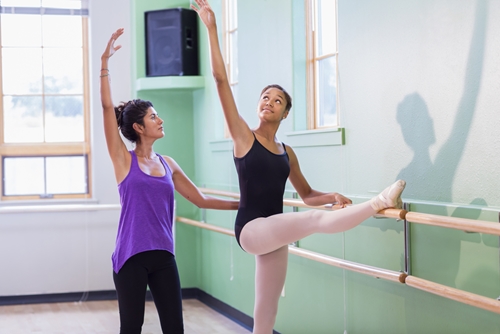If you are a dancer searching for the next step in your career, consider becoming a dance teacher. Switching from student to teacher is one of the biggest leaps you’ll ever make in your dance journey, but it’s also one of the most rewarding. Being a dance teacher requires lots of hard work, passion and resiliency, but if you can commit to making yourself the best teacher you can be, all the inevitable ups and downs you’ll face along the way will be well worth it. Read on for some strategies on how to become a dance teacher.
Benefits of Being a Dance Teacher
Not many people get to do what they love for a living. Granted that living may be small – dance teacher’s salaries are typically modest – but being able to constantly share the love of dance with others is priceless. You won’t have to whittle away the hours at a desk job while your heart yearns to dance, instead, you’ll be dancing and choreographing every day. And one of the few things that makes you feel better than following your own passion is inspiring others to follow theirs, too.
One of the most rewarding aspects of being a dance teacher is seeing your dancers improve. It’s that a-ha moment when a light bulb goes off and a student is finally able to perform a certain skill after months of practice. This rewarding feeling isn’t just limited to skills, though.
Another benefit of being a dance teacher is seeing your students grow personally. You’ll feel joy when you see insecure students gain confidence and shy students make friends. Dance is many things – an art form that inspires, a physical activity that keeps the body healthy and a provider of life lessons – and as a dance teacher, you’re responsible for making it all happen.
Qualities of Good Dance Teachers
Good dance teachers are those that not only have technical expertise but those are able to effectively communicate with students.
“Dancing ability and teaching ability do not go hand in hand,” wrote Rebecca King in a post for her blog, Tendus Under a Palm Tree.
You need to be able to teach just as well as you can dance. Dance teachers must possess a great deal of patience and the ability to stay calm under pressure or in the face of frustration. A certain skill might be second nature to you, but students may need to go over it again and again. They need to be able to pinpoint a specific issue that a student has and then offer constructive criticism that will help them improve.
They must be conscious of the tones they take when criticizing, too. You’ve likely been there before – a few harsh words of criticism that stuck in your memory or caused you to feel defensive. Even though criticism is necessary, we’re only human, so sensitivity is just as important.
Good teachers must also be able to empathize with their students and understand different learning styles and personality types. The stronger teachers can connect with their students, the more powerfully they can nurture a love of dance.
Teachers also have a responsibility to be role models for their students, noted UnityDance.org. Be conscious of your behavior, words and attitude in class, because your students aren’t just looking to you for advice on becoming better dancers – they’re looking to you for advice on what type of person they should be.
Realties to Be Prepared For as a Dance Teacher
With all the rewarding benefits of being a dance teacher, you’re going to face some stressful moments right alongside them. Students, particularly younger ones, will be antsy, distracted and unmotivated some days in class, and you’ll feel like everything you say goes in one ear and out the other. You’ll have to teach multiple age groups, body types and abilities, noted the blog Dance in Real Life, and it’s also physically demanding, with some teachers instructing four or more classes a day.
There will be days you want to stay home and have a break, or times when you wish you had a little more income. But those moments when you see your students’ faces light up as they learn a new skill or finish their first recital will make you forget about all the tough times.
Paths to a Career as a Dance Teacher
There are different ways of becoming a dance teacher, but no matter which path you take, it’s important to gain both teaching expertise and real-world experience. If you are a young student, enrolling in a college degree program in dance education is a great way to get started on your path to becoming a dance teacher, and you should also consider a dual degree in education and dance.
Research the regulations in the area you would like to work in, since many states require that teachers are certified, and even if it’s not required, education certifications will make you a stronger candidate. There are also graduate programs and training workshops that will help prepare you to be a dance teacher.
Look for opportunities to gain real-world teaching experience wherever you can. If you currently dance, ask the studio owner or your teacher if you can work as an assistant, volunteer teacher or intern. Helping out at a studio will give you valuable insight into what being a dance teacher is really like.


